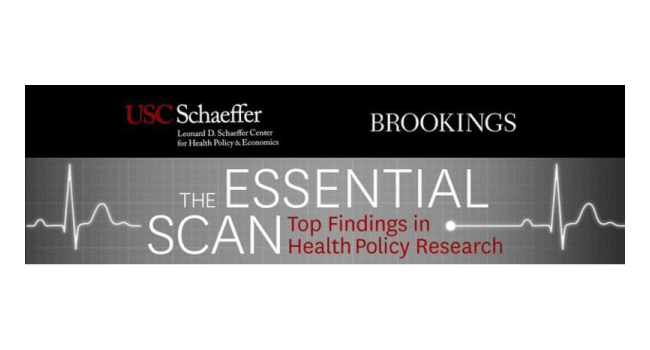What’s the latest in health policy research? The Essential Scan aims to help keep you informed on the latest research and what it means for policymakers. It is produced by the USC-Brookings Schaeffer Initiative for Health Policy, a collaboration between the Brookings Institution and the USC Schaeffer Center for Health Policy & Economics. To sign up to receive the Essential Scan straight to your inbox, sign up here.
A Medicaid Alternative Payment Model Program in Oregon led to Reduced Volume of Imaging Services
Study by: Stephan Lindner, Menolly R. Kaufman, Miguel Marino, et al.
The patient-centered medical home (PCMH) model, which includes a comprehensive assessment of a patient’s care needs, the coordination of services across providers, and an emphasis on quality, was developed to improve patient satisfaction and health outcomes associated with primary care delivery. However, the fee-for-service reimbursement model that many PCMHs are paid under may be hindering progress. A new study leverages a 2013 change that was implemented in Oregon’s Medicaid program to analyze the effect of payment reform on the PCMH model. Under the new policy, reimbursement for traditional primary care services was shifted from a per-visit model to per-patient rate at 15 community health centers. According to the study, this payment reform was associated with a 42% reduction in price-weighted traditional primary care services. This was fully driven by a decrease in use of imaging services. The authors argue that changing the primary care payment system from a per-visit to a per-member rate could eliminate financial disincentives in primary care and encourage physicians to reduce the provision of low-value care. Full study here.
Do Hospitals Respond to Changing Incentive Structures? Evidence from Medicare’s 2007 DRG Restructuring
Study by: Amanda Cook and Susan Averett
In 2007, the Centers for Medicare and Medicaid Services reorganized the diagnosis-related group (DRG) system by increasing the number of categories within a DRG to account for complications in certain patient conditions and allow for better reflection of differences in patient severity. A new study examines whether this change in the DRG system incentivized hospitals to list more complications in order to increase their reimbursements. The researchers used three separate methods to determine if hospitals responded to the DRG transition by systematically upcoding patients; evidence of upcoding was confirmed. The researchers’ most conservative estimate is an additional 3 percent of reimbursement is attributable to additional upcoding, equating to $20 billion in excess payments in 2008. The researchers found evidence of upcoding in government, non-profit, and for-profit hospitals as well as spillover effects impacting private insurance companies. Full study here.
State Policies for Prescription Drug Monitoring Programs and Adverse Opioid-related Hospital Events
Study by: Katherine Wen, Phyllis Johnson, Philip J. Jeng, Bruce R. Schackman, and Yuhua Bao
In recent years, a myriad of state policies and mandates have been enacted to boost prescriber use of Prescription Drug Monitoring Programs (PDMPs). Among the most prominent policies are comprehensive mandates for prescriber use of PDMP, laws that allow PDMP access to office staff, and interstate PDMP data sharing. Evidence of the effects of these policies on adverse opioid-related hospital events is limited. A new study leverages a database of 2011-2015 privately-insured and Medicare Advantage patients from 28 states to evaluate the effects of 3 PDMP policies on adverse opioid-related hospital events among patients with prescription opioid use. The researchers find comprehensive use mandates for prescriber use of PDMP at the point of care was associated with as much as 28% reduction in the probability of hospitalization. The study suggests that if comprehensive use mandates had been implemented in every state, 27,400 fewer individuals would have experienced opioid-related hospital events in the second half of 2015 alone. On the other hand, delegate laws and interstate data sharing were associated with only limited reductions. Interestingly, although patients 65 and older had a lower rate of such events, they saw a much larger reduction in opioid-related hospitalizations in response to comprehensive use mandates. PDMP policies may affect opioid-related hospital events through a combination of reducing the probability of overlapping opioid prescriptions, impeding misuse and overdose. Full study here.
Abandoning List Prices in Medicaid Drug Reimbursement Did Not Affect Spending
Study by: Benedic Ippolito, Joseph F. Levy, and Gerard F. Anderson
Historically, state fee-for-service Medicaid programs have based payments to pharmacies on a percentage of a drug’s list price. In 2013, the Centers for Medicare and Medicaid Services (CMS) commissioned the National Average Drug Acquisition Cost (NADAC) survey, which randomly samples outpatient pharmacies across the country and asks them to report invoice data on drugs purchased during the previous month. In the last few years, as fee-for-service Medicaid drug spending has evolved, most states have begun to leverage the NADAC and other invoice-based surveys for pricing. A new study examines whether this shift from list price–based reimbursement to acquisition cost (via-invoice surveys) has altered Medicaid outpatient drug spending. The researchers find this transition does not seem to have any significant effect on total outpatient drug spending. One reason for this is that while ingredient costs went down, dispensing fees significantly increased during the same time. The researchers argue that understanding whether total reimbursements to pharmacies are set at an appropriate level – regardless of how fees and ingredient costs are nominally split – is an important exercise for policymakers and stakeholders. Full study here.
Click here to receive The Essential Scan email.
The Essential Scan is produced by the USC-Brookings Schaeffer Initiative for Health Policy, a collaboration between the Brookings Institution and the USC Schaeffer Center for Health Policy & Economics.
